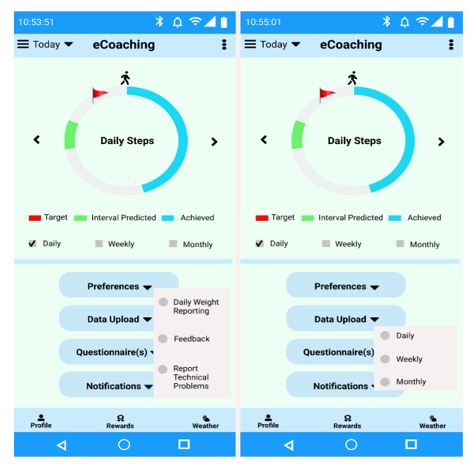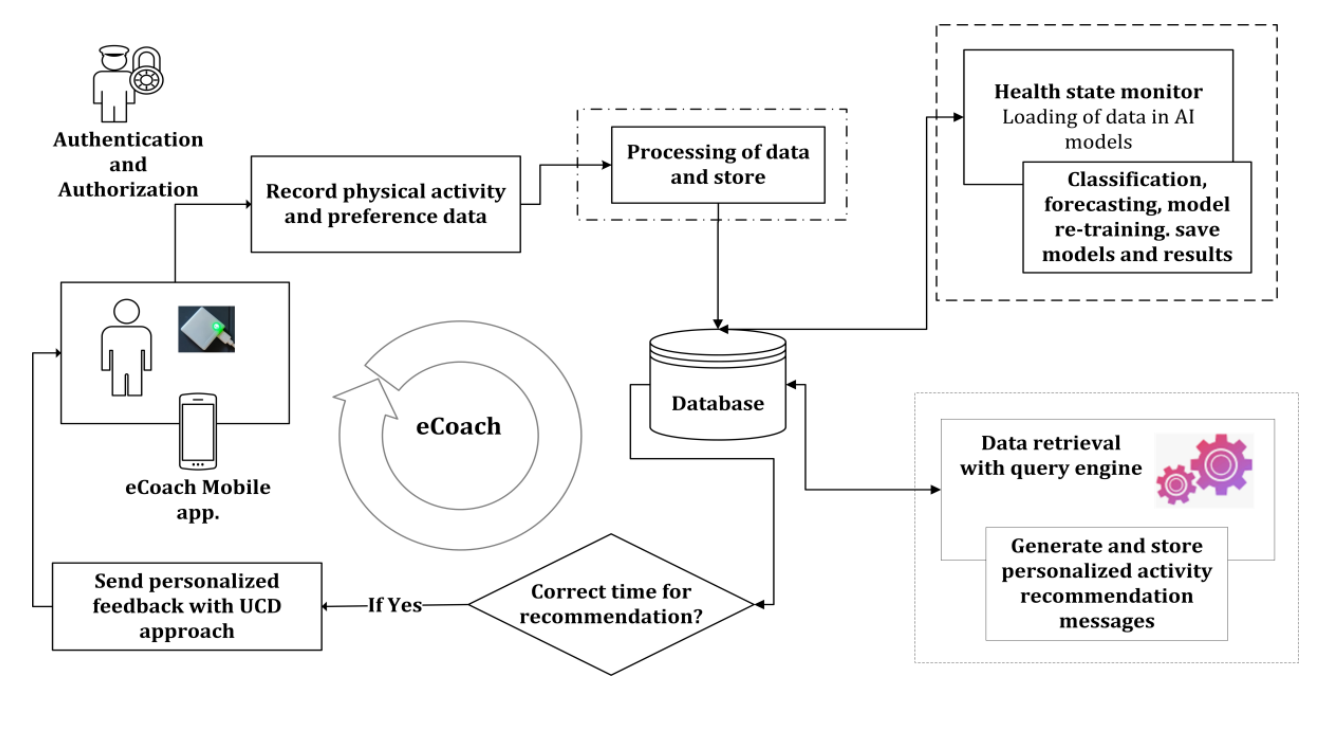Integrating technologies, concepts and strategies from interdisciplinary domains and users’ preferences and requirements in an engaging manner is required for the design and development of a health eCoach system. Chatterjee et al. (2022) investigated the best technique for developing an eCoach prototype. During their study, Chatterjee et al. used Maastricht Instruments’ MOX2 medical-grade (CE certified) low energy activity sensor for continuous activity monitoring.
Introduction
Chronic illness caused by lifestyle factors will be the leading cause of death worldwide. Lack of physical activities, improper dietary habits, excess consumption of tobacco and alcohol are severe risk factors for chronic diseases, such as obesity, overweight, hypertension, diabetes type II, cardiovascular diseases (CVDs), osteoporosis, and several types of cancer.
Healthy lifestyle management can be aided by self-management, motivation, coaching, regular monitoring, goal setting, goal evaluation reminders, and contextual tailored recommendations. Persuasive strategies like eCoaching can empower people to manage a healthy lifestyle by providing early risk projections and suitable customized guidance. The intended eCoach system is a collection of computerized components that form an artificial entity capable of observing, learning from, and predicting a user’s behaviors in context.
Goal of this study
The study focused on prevention by automatically generating meaningful and individualized lifestyle suggestions using an intelligent eCoach system to reinforce good habits (e.g., frequent physical activity). The study collected data (personal and activity data) from a healthy group of adult male and female participants, then analyzed the time-series data to see how lifestyle recommendations affected the participants’ reinforcement of positive habits. The study also collected personal preferences using a self-reporting form as well as activity data via a wearable activity sensor with minimal effort on the part of the participants. One of the main objectives was to create a self-management roadmap using eCoaching that would speed up progress, generate best practices, and enhance public awareness.
Methods
To develop a roadmap for self-management with eCoaching, Chatterjee et al. used an iterative user-centered design (UCD) approach with a dialogue-labs method to collect qualitative data from various users (i.e., researchers, non-technical and technical, health professionals, subject-matter experts, and potential end-users). They used multiple phases of the UCD technique and co-design events to create and develop the eCoach prototype in two stages. They worked on identifying end-users, understanding the user’s context, expressing user needs, and designing and constructing a low-fidelity eCoach prototype in the first UCD workshop. They focused on maturing low-fidelity solution design and development for the visualization of continuous and discrete data, AI-based interval forecasting, personalized recommendations, and activity goals in UCD workshop 2.

Figure 1. The iterative, user-centered eCoach prototype design and development methodology
Chatterjee et al. used the MOX2 medical-grade (CE certified) accelerometer-based low energy activity sensor from Maastricht Instruments for continuous physical activity monitoring in their project. The MOX2 was chosen for its validity, open interface protocol and opportunities to be embedded in a medical device eHealth intervention. The results of the sensors in smartphones (used by Apple, Samsung, and other service providers) are not reliable, because people do not carry their smartphones at the same body area throughout the day. Consumer activity trackers such as Fitbit also show high individual variability in older and/or sick people with a slow walking pattern, as was demonstrated in a recent study. Furthermore, it is impossible to predict when the manufacturer may upgrade the device’s algorithms or sensors, making clinical studies difficult (over longer durations). The majority of consumer physical activity monitors are less suitable for medical applications.
The MOX2 measures and transmits high-resolution physical activity data such as postural information (weight-bearing, sitting, standing) and activity intensity categorized in low physical activity (LPA), medium physical activity (MPA), vigorous physical activity (VPA), and steps per minute. The data can be used to classify physical activity (LPA, MPA, VPA) and determine posture (sedentary activities such as sitting or reclining, standing, and weight-bearing). The sensor is recommended to be worn on the thigh or waist.
Chatterjee et al. used a prototype Android MOX2 mobile app to capture individuals’ activity parameters into the smartphone’s download folder. Following the android secure file access policy, they used their created eCoach app to periodically upload the activity data to the eCoach backend server marked with the unique user-id. Participants had two options for uploading their activity data from their smartphone to the remote eCoach server: automatic (which would upload data at regular intervals) or manual (which would upload data manually) (if automatic data upload fails due to technical problems). In accordance with the General Data Protection Regulation (GDPR) and the norm for information security and privacy in health guidelines, personal health, wellness, and questionnaire data are sent from the eCoach app to a remote eCoach server via a REST API (HTTP POST) and stored in a Postgres database. With the questionnaire, complaint, or feedback (survey) data, no personally identifiable information was collected.

The MOX2-5 activity sensor is a three-dimensional accelerometer with a sample rate of 25 to 100 Hertz (dimensions 35 x 35 x 10 mm). It has a 4mg/LSB sensitivity. It’s dust and waterproof, has a seven-day battery life, and is powered by a rechargeable Lithium Ion 125 mAh battery. Cycling, swimming, rowing, and skiing are not suitable for classification into precise activity classes using the present version of the MOX2-5 activity sensor. As a result, in the current version of the eCoach app, the participants had to manually report them as questionnaire data.
Results
The UCD method assisted in the development of a functioning prototype of an eCoach system that meets end-user criteria and expectations for effective advice visualization while taking into account cultural diversity, quality of life, and human values. The design presents an early version of the solution, which includes wearable technology, a mobile app, and web content for self-monitoring, goal setting, and lifestyle advice in a fun way between the eCoach app and end-users.
At each level, the UCD approach incorporates a design focus on the user and their demands. Users have been at the center of the design process to build a working research prototype that improves the fit between technology, end-users, and researchers. Furthermore, Chatterjee et al. conducted a technological readiness assessment of ProHealth eCoach in comparison to European Union standards (EU).

Related products
MOX2 Bluetooth LE activity monitor
The MOX2 is a Bluetooth Low Energy accelerometer-based activity monitor embedded with proprietary physical activity monitoring algorithms. With a low power consumption, the device seamlessly measures and transfers high resolution activity parameters. Custom algorithms can be embedded on request.
More information about the MOX2
How can we help you with your research?
Maastricht Instruments creates equipment in the field for accelerometry. We provide support for Clinical research, E-health applications, accelerometry algorithms and data processing and analyses. Consult us about our accelerometry products, MOX1, MOX2, MOX3, MOX5 and BACE. or eHealth applications: Hospital Fit and Miss Activity
Reference
ProHealth eCoach: User-Centered Design and Development of an eCoach App to Promote Healthy Lifestyle with Personalized Activity Recommendations
